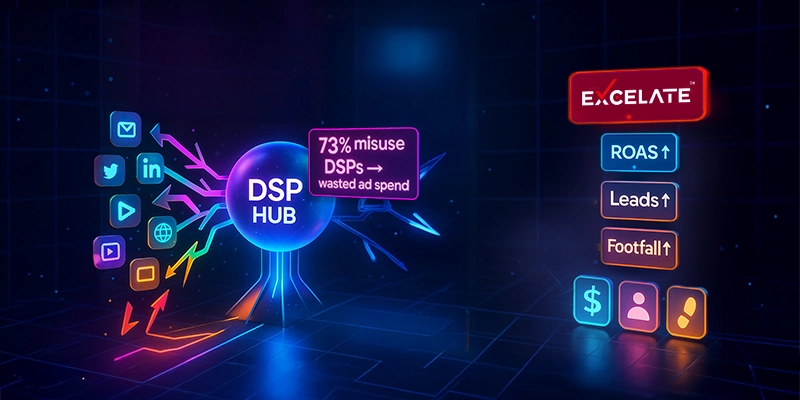Table of Contents
ToggleSection 1. Introduction: The Digital Marketing Revolution
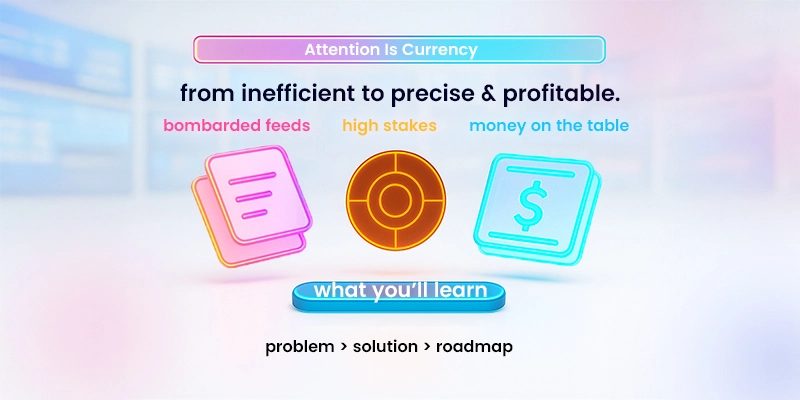
While the Demand-Side Platform (DSP) is the key to modern, efficient ad buying, a staggering 73% of businesses are failing to use it correctly, wasting time and money. This isn’t just inefficiency; it’s money left on the table. With consumer attention being the most valuable currency, digital advertising has become a high-stakes game. From social media feeds to streaming services and countless websites, consumers are bombarded with messages, making it harder than ever for brands to connect with their audience.
This guide will transform your programmatic approach from inefficient to profitable & precise:
The Problem: The manual process of buying ad space, negotiating with individual publishers, managing insertion orders, and tracking campaigns in separate spreadsheets is simply no longer viable. It’s inefficient, opaque, and fails to harness the vast amount of data available.
The Solution: The DSP is the intelligence hub that automates and optimizes your ad buying process, enabling marketers to bid on ad placements in real-time across diverse channels with precision.
Your Roadmap: We provide an actionable framework to master DSPs, from fundamentals to leveraging them to meet diverse business objectives, including brand awareness and lead generation, as well as future trends that will define the industry in 2025 and beyond, equipping you with the knowledge to stay ahead of the curve. With a special focus on the GCC, UAE, MENA, KSA, and Qatar regions, you’ll gain the insights needed to build a powerful strategy and maximize your ROI.
Section 2. Why Advertising Is Harder Than It Looks?
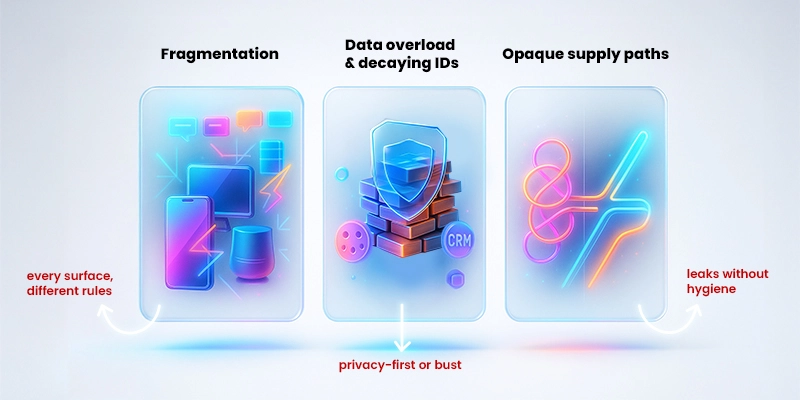
Fragmented attention and channels: Consumers bounce between mobile apps, mobile web, desktop, connected TV, podcasts, and public screens. Each surface has distinct identifiers, formats, and measurement quirks.
Data overload and decaying identifiers: Logs, pixels, SKAN/postbacks, first-party CRM events, and publisher signals flow into stacks that must respect regional privacy laws. Meanwhile, third-party cookies are no longer a stable backbone; Google has scrapped its plan to deprecate third-party cookies in Chrome fully and is instead focusing on “a new experience” that preserves user choice and privacy. Advertisers still need privacy-centric identity to future-proof plans. (Source: Edison Research, DoubleVerify).
Opaque supply chains: Between publisher and advertiser sit exchanges, SSPs, resellers, and data layers. Without supply-path hygiene, budgets leak to non-viewable, made-for-advertising (MFA), or fraudulent inventory. (Source: IAB Europe, IAB Tech Lab).
Bottom line: Modern media buying requires automation, verification, and privacy-safe data activation, precisely what a DSP integrates.
Section 3: What is a DSP?
3.1 Defining DSP: A Clear, Jargon-Free Explanation
Demand-side platforms (DSPs) are automated advertising systems that enable advertisers to plan, target, bid, buy, verify, and measure digital ad impressions across multiple publishers/exchanges through a single interface.
At their core, DSPs facilitate the buying of impressions across websites and apps based on the advertiser’s targeting parameters. This technology enables advertisers to reach specific audiences without negotiating directly with individual publishers.
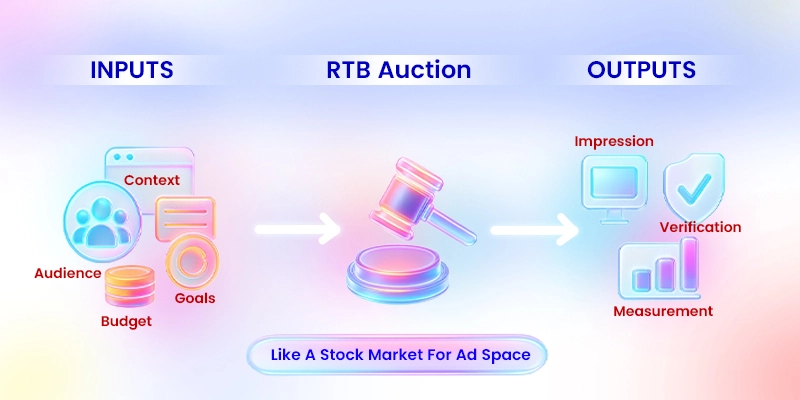
Think of a DSP as an automated stock market for digital ad space. Instead of a marketer having to call hundreds of websites to negotiate a banner ad price, a DSP connects you to a massive, global marketplace where they can bid for ad impressions in real-time.
The term «demand-side» is crucial. It signifies that this platform is on the demand side of the advertising equation; it serves the interests of the advertiser who is demanding ad space. This is in direct contrast to a Supply-Side Platform (SSP), which we’ll discuss shortly, and which serves the interests of the publisher who is supplying the ad space. DSPs connect to ad exchanges, which aggregate inventory from Supply Side Platforms (SSPs). This creates a comprehensive ecosystem: publishers utilize SSPs to sell their inventory, exchanges connect buyers and sellers, and DSPs assist advertisers in finding and purchasing the ideal inventory.
A DSP automates the process of buying ad impressions through Real-Time Bidding (RTB).
In the blink of an eye, as a user loads a webpage or app, the DSP analyzes thousands of data points to determine how much to bid for each impression, considering factors such as user demographics, browsing behavior, location, time of day, and the context of the ad placement. It then calculates the optimal bid price for that impression and, if it wins the auction, serves the ad to the user. This entire process, from bid to display, happens in under 100 milliseconds.
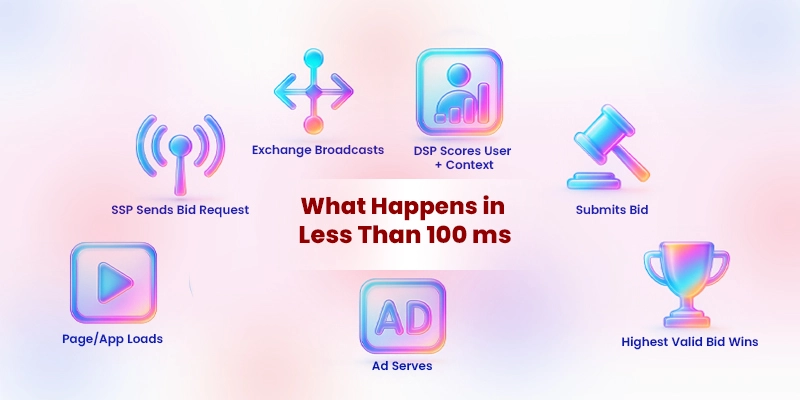
3.2 A Historical Context: From Manual IOs to Machine Decisions
To appreciate the power of a DSP, you must first understand the limitations of traditional ad buying. In the pre-programmatic era, ad buying was a tedious, manual process. An advertiser would contact a publisher (e.g., a news website) to book a specific number of ad impressions at a fixed price, a process known as direct selling or «programmatic direct.» This method was slow, lacked flexibility, and was difficult to scale. It was impossible to target specific users in real-time or to optimize a campaign as it ran.
The shift to programmatic buying was driven by the explosion of digital data and the need for greater efficiency, scale, and precision in targeting.
Early ad networks emerged to aggregate inventory from multiple publishers, but they were still limited in their capabilities.
The true revolution and the industry shift began from direct insertion orders to bulk ad network buys with the introduction of Real-Time Bidding (RTB) and the platforms that supported it: DSPs and SSPs, because automation scales, learns, and optimizes.
This automation unlocked the ability to target the individual user/ context-centric using signals (context, device, geo, time, creative, identity) to decide each auction, not just the website, and to make instant, data-driven decisions that maximized ad spend.
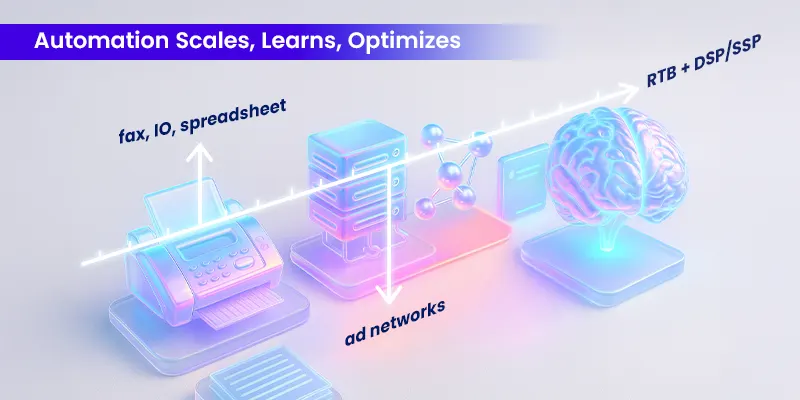
3.3 The Programmatic Ecosystem Explained
Digital advertising is powerful, but crowded, opaque, and increasingly regulated. Manual buying and fragmented tools waste budget. Programmatic advertising, and specifically the Demand-Side Platform (DSP), solves for scale, precision, and accountability by making data-driven buying decisions in real time across channels.
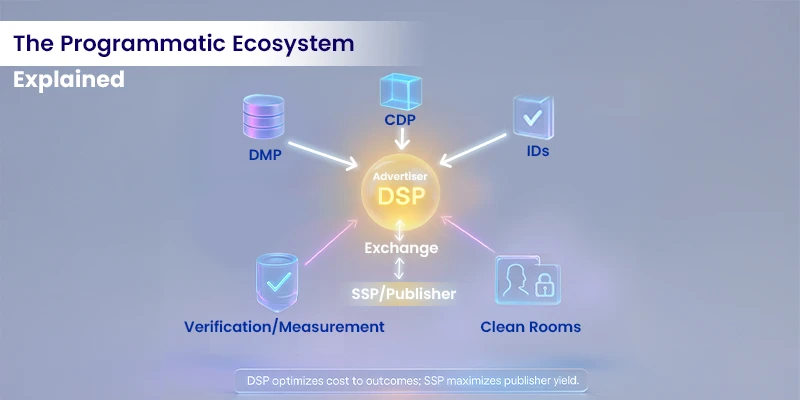
Two realities frame 2025:
Privacy is shifting without Chrome’s cookie deprecation. Google is maintaining third-party cookies in Chrome, while the industry advances privacy-centric methods (clean rooms, authenticated audiences, and advanced contextual). Source: Reuters, The Verge.
Budgets are moving to measurable surfaces. Retail media surges (US retail media is projected to reach approximately $52B in 2024, still accelerating), CTV is mainstream, and programmatic audio continues to gain momentum. Source: Emarketer.
It’s important to differentiate DSPs from other components in the ad tech stack. The programmatic advertising ecosystem is a complex web of interconnected platforms. To master programmatic, you must understand the role of each key player.
DMPs (Data Management Platforms): The Data Backbone
A DMP is a centralized data warehouse that collects, organizes, and analyzes audience data from various sources (cookies, mobile device IDs, etc.).
DMPs/CDPs and privacy-centric IDs (e.g., UID2, LiveRamp ATS) enable addressable reach without third-party cookies.
While some DSPs have integrated DMP capabilities, a standalone DMP provides the raw intelligence that feeds into the DSP’s targeting algorithms, enabling more precise and personalized ad delivery.
DSPs (Demand-Side Platforms): The Buyer’s Hub
As the central hub for advertisers, the DSP’s primary role is to give marketers a single interface to buy ad space across a vast network of websites, apps, and other digital channels.
Key functions include campaign management, budget control, and, most importantly, advanced audience targeting and bidding.
SSPs (Supply-Side Platforms): The Seller’s Hub
An SSP is the counterpart to the DSP. It is a software platform used by publishers (the «supply» side) to manage and sell their ad inventory.
The SSP’s job is to make a publisher’s inventory available to multiple DSPs simultaneously, running an auction to ensure that the publisher or website and app owners maximize revenue from their ad inventory and receive the highest possible price for each ad impression.
Bottom Line: DSPs optimize for the lowest effective cost for advertisers, SSPs optimize for the highest possible yield for publishers.
Ad networks
Ad exchanges are the central digital marketplaces where DSPs and SSPs connect, typically bundle inventory from multiple publishers, and sell it as packages. They are the virtual auction houses where ad impressions are bought and sold in real time.
The exchange receives a bid request from a publisher’s SSP, broadcasts it to various DSPs, collects the bids, and awards the impression to the highest bidder.
Bottom Line: Unlike DSPs, ad networks often lack the transparency and precise targeting capabilities that make DSPs valuable.
Verification & measurement
- Third parties (e.g., DoubleVerify) provide pre-/post-bid brand safety, viewability, fraud filters, and attention/quality metrics. (Source: MAGNA)
3.4 How Real-Time Bidding (RTB) Works
The magic of a DSP is its ability to make an instantaneous, informed decision on whether to buy an ad impression and at what price. This process, known as Real-Time Bidding (RTB), is a sophisticated mix of data and algorithms.
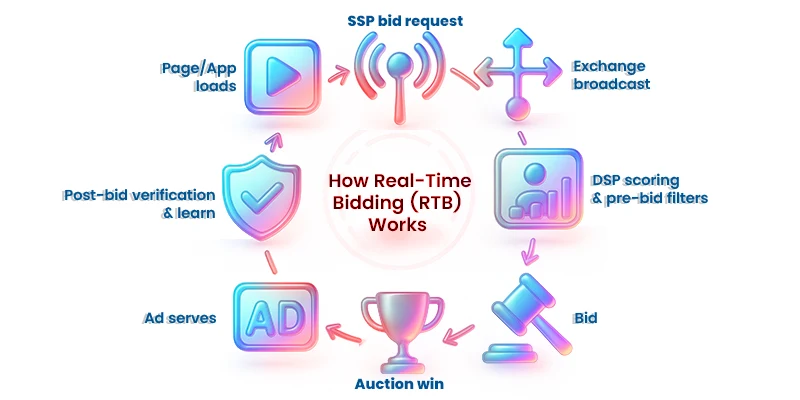
Here’s how it works in practice:
User Event: Triggers a bid request with context (page/app, placement, device, IP/geo, consent signals).
Bid Request: The publisher’s SSP sends a bid request to the ad exchange. This request contains information about the user (anonymized data, such as location and device type) and the ad placement (size and position on the page).
Bid Broadcasting: The ad exchange broadcasts this bid request to hundreds of DSPs.
DSP Scores the opportunity against your goals and constraints; applies pre-bid filters (brand safety, fraud, viewability, domain/app lists).
DSP Analysis and Bid: Each DSP evaluates the request against its advertisers’ campaign criteria. Is the user in the right geographic location? Are they within the target demographic? Did they recently visit the brand’s website? The DSP’s algorithm analyzes this data in milliseconds, calculates the user’s value to the advertiser, and submits a bid.
Auction and Ad Serve: The ad exchange runs a quick-fire auction. The highest bidder wins, and their ad is instantly served to the user’s screen.
Post-bid analysis logs viewability, IVT outcomes, conversions, and feeds learning systems.
This entire process occurs so quickly that the user never even notices it, yet it enables a level of efficiency and targeting that was unimaginable just a decade ago.
3.5 What “Good” DSPs Provide
Targeting depth: Demographic, geo, device, behavioral, intent, contextual, lookalike/predictive.
Creative intelligence: Dynamic Creative Optimization (DCO), sequential messaging, and format-aware rendering.
Automation: Budget pacing, frequency caps, bid modifiers by time/geo/device, rules-based optimization.
Analytics: Real-time dashboards, cohort and path analysis, incrementality/attention insights, and export to BI.
Section 4: Understanding Placements, Channels, and Ad Formats
4.1 The Omnichannel Approach
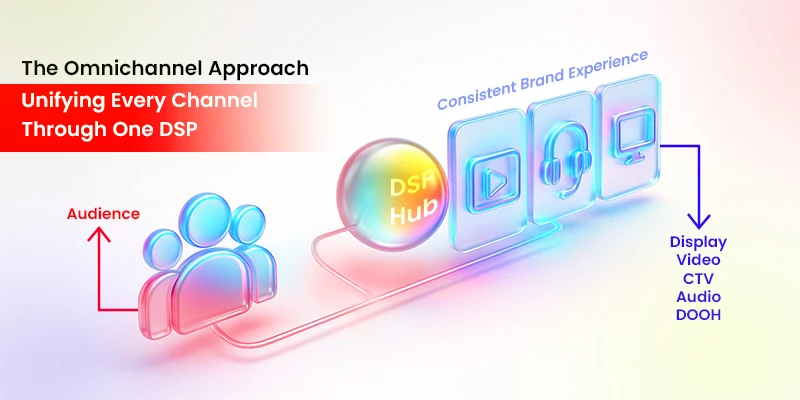
The modern consumer’s journey is not confined to a single channel. They move seamlessly between websites, mobile apps, social media, and streaming services. An effective DSP must be omnichannel, providing a unified platform to manage campaigns across all these channels. This is critical for creating a consistent brand experience and for gaining a holistic view of campaign performance.
4.2 A Channel-by-Channel Breakdown
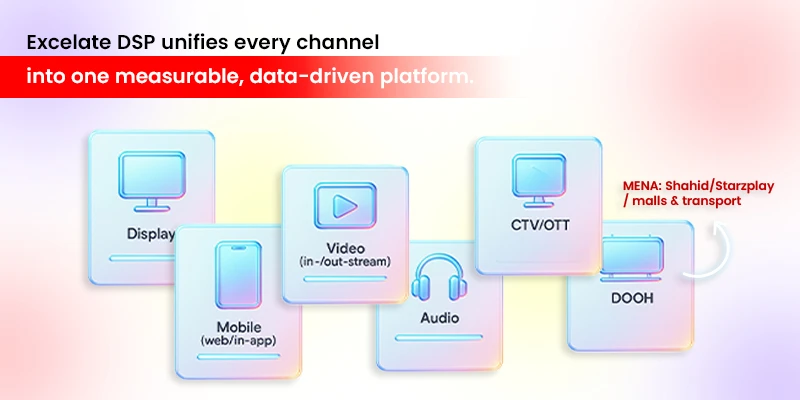
Display Advertising / Display (web & in-app):
Still foundational for reach and retargeting; now attention/quality-driven. This is the classic, most recognizable form of programmatic advertising.
It includes standard banner ads and more engaging rich media formats that can include video and interactive elements.
Despite being an older format, display ads remain a fundamental component of any DSP strategy, especially for brand awareness and retargeting.
Mobile Advertising:
With mobile penetration rates over 100% in many parts of the GCC, mobile advertising is a dominant force.
DSPs differentiate between in-app and mobile web inventory, each with its own unique targeting capabilities.
In-app advertising (IDs and SDK signals) increases precision and is especially popular due to its high engagement rates and the ability to utilize mobile device IDs for precise audience targeting.
Video Advertising:
Video has become a core component of digital advertising. DSPs manage video ad placements in various forms:
In-stream: Ads that play before, during, or after video content (e.g., YouTube pre-roll ads).
Out-stream: Ads that appear in non-video environments, such as within a news article.
The growth of short-form video ads on platforms like TikTok and Instagram has also created a new, highly engaging format for DSPs to leverage.
Connected TV (CTV) and OTT:
As more consumers in the MENA region shift from traditional broadcast TV to streaming services like Shahid and Starzplay, advertisers are following their attention. A surge channel with TV-like experience and digital precision; adoption is mainstream. (Source: Reuters)
DSPs are now the primary way to buy ad inventory on these platforms, offering the ability to target household-level data and to reach a highly engaged audience with a TV-like experience.
This is a game-changer for brands seeking to combine the brand-building power of television with the targeting precision of digital.
Audio Advertising:
The rise of podcasts and music streaming services has created a new channel for programmatic.
DSPs can now buy ad placements on audio platforms, targeting users based on their listening habits, the genre of content, and their demographic data.
This is a powerful way to reach audiences who are on the go and who may be difficult to reach on other channels.
Target by content/genre/moments; smart-speaker and streaming penetration support scaled audio buys. (Source: Edison Research)
Digital Out-of-Home (DOOH):
Programmatic is moving beyond the screen in your hand to the screens in the city.
Programmatic Digital Out-of-Home (DOOH) allows advertisers to buy ad space on digital billboards and screens in public spaces, such as malls and airports. The ads can be dynamically served based on real-time data, such as the time of day, weather, or even the type of crowd walking by.
In the GCC, with its focus on modern urban development and major events like the World Cup and Expo, DOOH is a key growth area. The market size for GCC OOH advertising is projected to reach USD 6.31 billion by 2033, with programmatic DOOH being a major driver of this growth. Screens in malls, towers, transport, and retail, now programmatically addressable. In GCC, OOH is a growth market through 2033, with programmatic as a driver. (Source: spideraf.com)
Section 5: The Crucial Role of Brand Safety, Ad Fraud, and Transparency
As programmatic has grown in scale, so have the challenges of brand safety and ad fraud. For a brand to be truly successful, it must protect its reputation and ensure its ad spend is not wasted on fraudulent traffic.
5.1 Brand Safety vs. Brand Suitability
It’s crucial to understand the difference between these two terms.
Brand Safety: This is about ensuring your ads do not appear next to harmful, illegal, or inappropriate content (e.g., hate speech, violence, illegal drugs). Brand safety is a non-negotiable, universal standard.
Brand Suitability: This is about defining the contexts a brand is comfortable appearing next to. For a children’s toy company, an ad on a comedy website might be unsafe, while for a movie studio, it is perfectly suitable. This is a more nuanced, brand-specific concept.
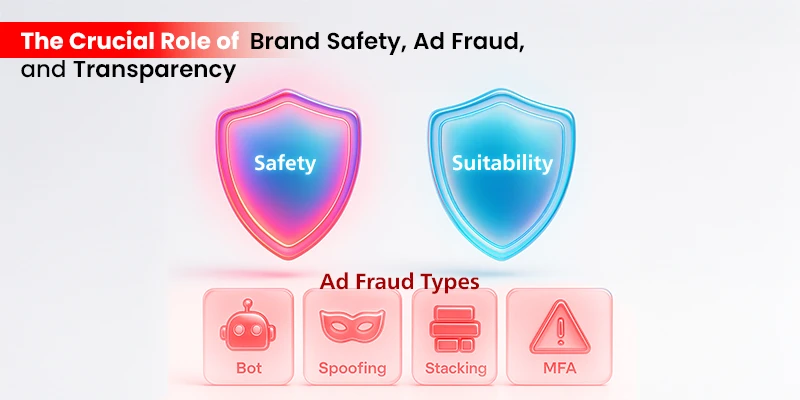
5.2 The Problem of Ad Fraud
Ad fraud is the practice of attempting to defraud digital advertisers by artificially generating fake ad traffic. It’s a multi-billion-dollar problem that drains ad budgets and pollutes campaign data.
IVT (bots/data-center traffic), click farms, domain/app spoofing, pixel stuffing, stacked ads, and MFA sites. Global loss estimates vary, but independent trackers show tens of billions in exposure. (Source: Mordor Intelligence)
Common types of ad fraud include:
IVT/ Bot/ Data-centre Traffic: Non-human traffic generated by automated bots or scripts that mimic genuine user behavior, clicking, viewing, or engaging with ads, to inflate impression and click counts.
Click Farms: Large-scale operations of low-wage workers or automated systems manually clicking ads or generating fake app installs to simulate engagement and drain advertiser spend.
Domain/ App Spoofing: Fraudsters misrepresent low-quality or non-existent websites and apps as premium inventory by falsifying domain or app IDs, tricking advertisers into paying higher rates.
Pixel Stuffing: Multiple ads are crammed into a single pixel, invisible to the human eye but still counted as impressions, falsely inflating ad delivery metrics.
Stacked Ads: Several ads are layered on top of one another within the same ad slot, meaning only the top ad is visible while others below still record impressions.
MFA Sites: Websites designed purely to host ads and drive programmatic revenue, often filled with low-quality or scraped content that generates no meaningful engagement.
Impression Fraud: Ad impressions are reported as served, even when no real user saw them, through techniques like hidden iframes or falsified ad calls.
According to a 2025 report by Spider Labs, global ad fraud losses are projected to reach $41.4 billion, underscoring the urgent need for stronger verification, transparency, and AI-driven fraud detection across the ad supply chain.
5.3 How DSPs Combat Fraud and Ensure Safety
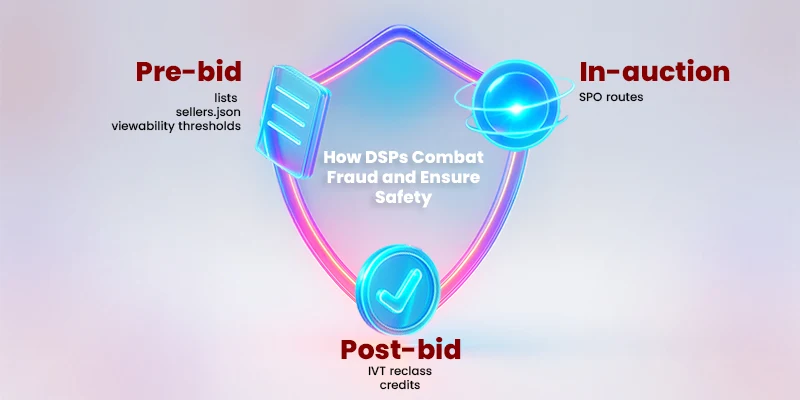
The best DSPs are proactive in their fight against fraud and a brand’s reputation.
Pre-bid and Post-bid Protection: DSPs use real-time verification to prevent fraudulent activity (blocklists/allowlists, ads.txt/sellers.json checks, viewability/IVT thresholds, domain/app quality, MFA filters, language/region rules) before a bid is placed (pre-bid), and they also filter out invalid traffic (IVT reclassification, clawbacks/credits, attention diagnostics, and supply remediation) after the fact (post-bid).
AI-Powered Fraud Detection: Modern DSPs leverage machine learning to detect unusual patterns and anomalies in traffic, such as a sudden spike in clicks from a single IP address, that may indicate bot activity. This is the most effective way to combat increasingly sophisticated fraud tactics.
Supply Path Optimization (SPO): A practice where DSPs analyze and streamline the ad supply chain, ensuring that advertisers are buying inventory from the most direct and transparent sources. This minimizes the risk of fraudulent resellers and provides greater visibility into ad spend. Shorten paths, cut resellers, prefer direct or high-quality SSP routes, and adopt emerging buy-side transparency standards like buyers.json and DemandChain. (Source: IAB Europe, IAB Tech Lab)
5.4 Privacy 2025: Identity Without Third-Party Cookies
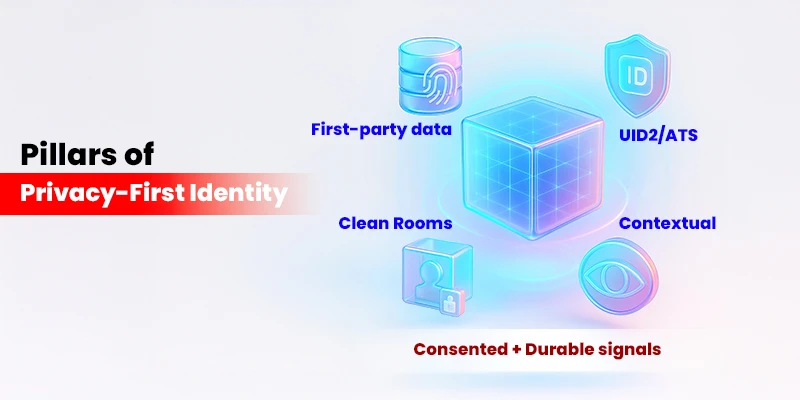
The global regulatory landscape is changing rapidly. The deprecation of third-party cookies and the enforcement of laws like the GDPR and CCPA have forced DSPs to adapt. Google confirmed it won’t proceed with cookie deprecation as originally planned, yet the market remains oriented to privacy-centric solutions that rely on first-party data, contextual targeting, and data clean rooms to maintain effectiveness while respecting user privacy.
Today’s resilient stack blends:
First-party data via CDPs/CRMs.
Authenticated IDs such as UID2 and LiveRamp ATS that match consented signals into tokens usable across the open web/CTV. (Source: unifiedid.com, LiveRamp)
Data clean rooms (DCRs) for secure data collaboration are increasingly mainstream among large brands. (Source: Grapeseed Media)
Implication: Even as cookies persist in Chrome for now, plan for identity diversity and consented, durable signals.
Section 6: How to Maximize Your Demand Side Platform in 2025
6.1 Choosing the Right DSP
With over 150 DSPs available in 2025, selecting the right one requires careful consideration of your specific needs and goals. The core function of a DSP is to help advertisers find and purchase the most valuable impressions for their target audience at the best possible price.
When comparing top DSPs, it’s essential to recognize that each platform has its own strengths.
For example,
The Trade Desk excels in cross-channel capabilities and transparency
Google Display & Video 360 offers robust integration with other Google products.
Excelate DSP by MEmob+ is a cutting-edge programmatic advertising platform designed to optimize digital media buying through artificial intelligence, automation, and data-driven insights. Excelate offers advertisers the ability to streamline their campaigns, maximize efficiency, and reach the right audiences across multiple channels.
Amazon DSP provides unparalleled access to Amazon’s first-party shopping data, and MediaMath stands out for its sophisticated AI-powered optimization tools.
6.2 Features to Consider
When evaluating DSPs, focus on these critical features that will impact your advertising effectiveness in 2025:
Inventory access: The breadth and quality of available ad inventory across websites, apps, and connected TV platforms
Targeting capabilities: The precision and flexibility of audience targeting options
Cross-device tracking: The ability to reach users across multiple devices and platforms
Reporting and analytics: The depth and clarity of performance data and insights
Integration capabilities: How well the DSP connects with your existing tech stack and data sources
Customer support: The availability and quality of technical assistance and strategic guidance
User interface: The platform’s ease of use and workflow efficiency
Research by Advertiser Perceptions shows that marketers now rank data integration capabilities as the top consideration when selecting a DSP, followed by transparency in fees and performance.
6.3 Understanding Pricing Models
DSP pricing structures vary significantly, and understanding these models is crucial for maximizing your return on investment:
Percentage of media spend: The most common model where the DSP charges 10-20% of your total ad spend
CPM (Cost Per Mille) fee: A fixed rate added to each thousand impressions purchased
SaaS (Software as a Service) model: A monthly or annual subscription fee, often with tiered pricing based on usage
Hybrid models: Combinations of the above approaches, sometimes with minimum spend requirements
Advertisers who deeply understand their DSP’s pricing model achieve 15-20% better cost efficiency compared to those who don’t.
For smaller businesses with budgets under $5,000, platforms like Excelate provide an alternative to Enterprise-level advertisers, who typically benefit from the advanced features and custom pricing structures of these platforms.
Section 7: A Spotlight on Excelate DSP by MEmob+
While global players dominate the DSP market, Excelate DSP by MEmob+ is built specifically to meet the advertising challenges of the MENA and GCC markets. Excelate delivers AI-powered automation, regional data intelligence, and SME-friendly economics, enabling businesses to run enterprise-grade campaigns with simplicity, transparency, and measurable outcomes.
7.1 Introduction to Excelate DSP
Excelate DSP is an AI-ready, omnichannel DSP & DV SaaS Platform built by MEmob+ with a deep understanding of the MENA and GCC consumer, leveraging AI and data-driven insights to optimize digital media buying and for measurable performance with regional precision while integrating AllPings location intelligence to bring real-world behavioral data into digital advertising.
Designed to democratize programmatic, Excelate makes high-quality advertising accessible to SMEs with a low minimum spend of $5,000, managed or self-service options, and no long-term commitments.
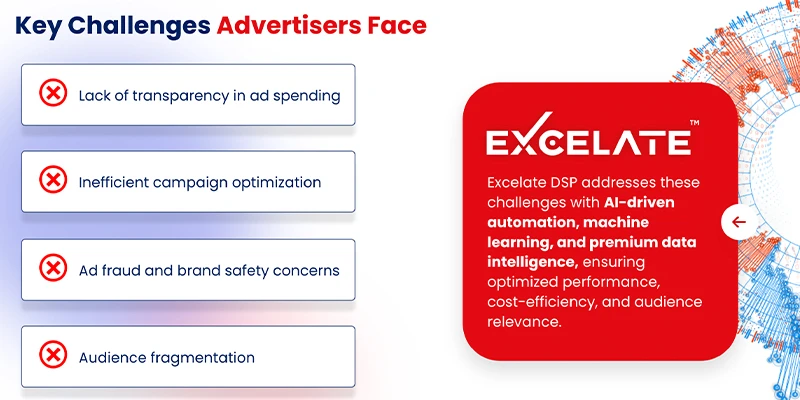
7.2 Scale & Access
Excelate delivers both global reach and regional precision:
- 2+ billion monthly ad impressions
- 15+ premium ad exchanges
- 10+ direct publisher partnerships (via PixelPluses SSP)
- Coverage in 195 global markets
- Inventory across CTV, display, in-app, mobile web, and DOOH
7.3 Core Capabilities
Excelate stands out by offering a unique blend of global-standard features with a distinct regional focus.
- AI-Powered Automation: Manage campaigns at scale while reducing operational overhead.
- High-Quality Ad Placements: Premium inventory with 99%+ viewability rates across formats (interstitial, MPU, display, native, video).
- Advanced Retargeting: Track user journeys and re-engage audiences at campaign, strategy, or user level.
- Real-Time Bidding & Optimization: Machine learning supports cost and performance optimization with live adjustments.
- Unique Audience Personas: Excelate enables precise targeting using 17K+ audience profiles, 300+ proprietary taxonomies, and 800K+ verified data points.
7.4 Key Features and Functionalities
A Excelate DSP’s power lies in its comprehensive suite of tools designed to optimize every facet of a campaign.
Audience Targeting: Deep Dive into Every Method
Targeting is a DSP’s single most critical function. It enables brands to move beyond a shotgun approach to a sniper strategy, reaching the right person with the right message.
Demographic and Geographic: The most basic forms of targeting, allowing for the segmentation of audiences by age, gender, income, and location. This is particularly relevant for the GCC region, where a marketer can precisely target an ad to a user in Riyadh, Doha, or Dubai, based on a product’s local relevance.
Behavioral and Interest-Based: This is where Excelate truly shine. By analyzing a user’s past browsing behavior, search queries, and app usage, DSPs can infer interests and serve highly relevant ads. A user who frequently reads about investment news might be a target for a financial services ad.
Contextual Targeting’s Resurgence: With the deprecation of third-party cookies, contextual targeting is making a powerful comeback. This method serves ads based on the content of the page itself, without relying on user data. An ad for hiking boots placed on a blog about hiking trails is a perfect example.
Lookalike and Predictive Audiences: Lookalike modeling is a powerful feature that allows a Excelate to find new users who share similar characteristics with a brand’s most valuable customers. By uploading a list of loyal customers, the DSP’s algorithm can find and target a new audience with a high probability of converting.
Location Intelligence and Mobility Insights:
- This is a key differentiator. MEmob+’s proprietary Excelate DSP leverages mobility insights to understand a user’s real-world movements and behavior. For example, it can target an ad to a user who has recently visited a competitor’s store or to an audience that frequently visits a specific mall in Doha or Riyadh. This goes beyond simple geo-fencing, providing a deeper understanding of consumer behavior to drive both online and offline conversions.
Creative Management: From Static to Dynamic
A DSP isn’t just for buying; it’s also for serving the right ad creative. The platform features a creative studio that automates the generation of dynamic ad creatives.
DCO automatically generates countless versions of an ad, with different headlines, images, and calls-to-action (CTAs), based on real-time data about the user. This ensures the ad is hyper-personalized, resonates with the specific user, leading to higher engagement and conversion rates.
Campaign Automation:
Excelate DSP automates the tedious parts of campaign management.
- Features like budget and frequency capping ensure that a campaign stays within its spending limits and that users don’t see the same ad too many times, making it less annoying.
- Bid modifiers enable marketers to adjust bids for specific variables, such as bidding more aggressively for users on a particular mobile device or at a specific time of day.
- IP, DMA, and device targeting
- Network targeting (Wi-Fi vs mobile)
- User-friendly dashboards for campaign setup and launch
Dashboards, Analytics, and Reporting:
Exclelate provides transparent, real-time analytics and reporting.
- Marketers can monitor key metrics, such as impressions, clicks, conversions, and cost-per-acquisition (CPA), as the campaign runs, allowing for instant adjustments and optimization.
- User-controlled dashboards, configurable reports, and A/B/post-bid analytics feed continuous learning. Machine-learning optimization supports RTB cost/performance controls and granular journey tracking/retargeting.
- Customizable dashboards with real-time reporting.
- A/B and post-bid analytics for continuous optimization.
- Machine-learning optimization for ROAS and journey-based retargeting.

Transparency and Control:
For SMEs, the complexity of programmatic advertising can be a major barrier. Excelate addresses this with an intuitive interface and transparent reporting, giving marketers full visibility into their ad spend, audience reach, and performance metrics, empowering them to make smarter decisions without the need for a large in-house team.
Blockchain Integration:
MEmob+ is a pioneer in integrating blockchain technology into its ad-tech solutions in the MENA region. Blockchain provides an immutable and transparent ledger for ad transactions, which is a powerful tool for combating ad fraud and building trust. This feature is particularly relevant in a region where transparency in ad spend is a growing priority for brands.
7.5 Data Advantage: AllPings Integration
Excelate leverages AllPings for:
- Precise & unique audience segmentation
- Enriched Insights and geo-aware activation
- Real-world mobility insights (2M+ POIs and location SDK)
- Conquesting strategies (targeting competitor visitors)
- OOH-to-mobile retargeting

This integration is what sets Excelate apart in the GCC, where physical movement and offline conversions matter as much as online clicks.
7.6 Brand Safety & Integrity Stack
Compliance: built-in support for GDPR/CCPA-style controls.
Fraud & suitability: AI-powered prevention, pre-/post-bid controls, and DoubleVerify integrations.
Together, this gives advertisers a strong pre-bid filter plus post-bid transparency for remediation. Excelate ensures every impression is delivered in safe, brand-appropriate environments.
7.7 Omnichannel Execution

Excelate unifies execution across:
Connected TV (CTV)
Display (Mobile in-app and web)
Programmatic DOOH
Desktop display
All within one seamless workflow with contextual, device, geo and frequency controls, delivering a consistent brand experience across devices.
7.8 Contextual Targeting for a Cookieless Reality

Excelate’s contextual engine analyzes content in real time to match ads to the right environments, ensuring:
- Privacy compliance (no cookies or PII reliance)
- Brand suitability and safety
- Higher engagement through contextual relevance
- Cross-channel activation (web, app, CTV)
7.9 Economics & Fit
- Low minimums: start at $5,000, with managed service options and no long-term commitments. Tailored to SMEs and growth teams needing enterprise-grade capabilities without enterprise overhead.
- Public product pages reinforce Excelate’s focus on AI-driven optimization, transparency, and cross-channel reach. (MEmob)
7.10 Ideal User Profile
Excelate DSP is an ideal solution for:
SMEs in the MENA and GCC regions: Businesses looking for a cost-effective, transparent, verifiable performance, easy-to-use platform with powerful targeting capabilities.
Brands focused on real-world impact: Businesses in retail, F&B, and automotive that need to drive foot traffic and measure offline conversions.
Marketers who value transparency and fraud prevention: Brands that want to ensure their ad spend is protected and that they have a clear view of where their ads are running.
7.11 Proof: Representative Outcomes
Excelate case studies highlight footfall lift and ROAS in GCC retail/QSR/luxury contexts, using AllPings to identify, reach, and measure high-value audiences.
Case Study – Skechers Hajj Season Campaign
- Objective: Promote Skechers’ Hajj collection with store visits as the key KPI.
- Strategy: Leveraged location intelligence (AllPings) and Excelate’s programmatic capabilities.
- Results:
- 4.44x ROAS
- 340,839 store visits
- 12.76% conversion rate
More case studies are available via MEmob+’s case study hub.
Section 8: Applications and Industry-Specific Use Cases
8.1 The Universal Utility of DSPs
DSPs are versatile tools that can be adapted to serve a wide range of marketing objectives.
- Brand Awareness: DSPs can be used to achieve massive reach, ensuring a brand’s message is seen by a wide audience in a short period.
- Conversions and Lead Generation: Through precise targeting and retargeting, DSPs are highly effective at driving specific actions, such as product purchases or form submissions.
- Audience Building: Marketers can utilize a DSP to create and segment custom audiences for future campaigns, leveraging data collected from their own properties.
8.2 DSPs Across Industries
Programmatic advertising is not a one-size-fits-all solution. Its application varies significantly across different sectors, each with its own unique goals and challenges.
E-commerce and Retail:
In the GCC and wider MENA region, the e-commerce sector is booming, with digital payment volumes rising dramatically in countries like Saudi Arabia.
- DSPs are indispensable for e-commerce brands, enabling them to drive sales and recover abandoned carts.
- By leveraging a DSP’s retargeting capabilities, a brand can show personalized ads for the exact products a user was browsing, significantly increasing the likelihood of a sale.
- The ability to use location data to drive in-store traffic is also a major advantage in this sector.
Mobile Gaming:
The mobile gaming market in the MENA region is experiencing explosive growth.
- DSPs are the go-to solution for mobile game developers looking to acquire new, high-value users.
- They use DSPs to target users based on their in-game behavior, device type, and app usage, and to run rewarded video ad campaigns that offer in-game benefits in exchange for watching an ad.
B2B and Enterprise:
B2B marketing requires a different level of precision.
- Instead of reaching millions of consumers, the goal is often to reach a small number of key decision-makers.
- DSPs facilitate this through Account-Based Marketing (ABM), where marketers can target ads to employees at specific companies or to professionals with a particular job title, making programmatic a powerful tool for lead generation and brand building in the enterprise space.
Travel and Hospitality:
Geotargeting is a key feature for the travel industry, making it a standout for DSPs.
- A hotel in Dubai can target ads to tourists in a specific country or city as they are planning their trip.
- DSPs can also use audience data to target users who have recently searched for flights, hotels, or travel destinations, providing a highly relevant ad experience.
Finance and Fintech:
The financial services industry operates under strict regulations.
- DSPs allow for compliance-first targeting, ensuring that ads for financial products are shown only to the relevant audience while adhering to data privacy laws.
- In a region like the GCC with a rapidly maturing fintech sector, this is non-negotiable.
Section 9: Trends Shaping the Future of DSPs (2025-2026)
The programmatic industry is in a constant state of evolution. The years 2025 and 2026 will be defined by a few key transformative trends.
9.1 The Cookieless Era and Its Aftermath
The single most significant trend is the complete demise of the third-party cookie. While this presents a challenge, it also creates an opportunity for smarter, more privacy-conscious advertising.
First-Party Data is Gold: Brands will place a much higher value on data they collect directly from their customers (e.g., website sign-ups, purchase history, app usage). This first-party data will become the foundation of targeting.
The Rise of Data Clean Rooms: To leverage data from multiple sources without violating privacy, brands and publishers will use data clean rooms. These secure, neutral environments allow companies to match and analyze their data without exposing the raw, personal information of their customers.
The Return of Contextual Targeting: Contextual targeting, once seen as a relic of a bygone era, will become a central pillar of programmatic strategy. AI will enable highly sophisticated contextual targeting, ensuring ads are not just placed on a «travel» website, but on a page about «family-friendly resorts in the UAE» to a user in a relevant mindset.
9.2 The AI & Machine Learning Revolution
Artificial Intelligence is no longer just a feature; it is the core engine of the modern DSP. By 2025, over 80% of digital media marketers will be using AI in some form.
Explainable AI: In the past, AI in programmatic was a «black box» where the algorithms’ decisions were not transparent. The future is «explainable AI,» where DSPs provide clear insights into why a certain user was targeted or why a specific bid was made. This builds trust and gives marketers more control.
Predictive Analytics: DSPs will use predictive analytics to forecast campaign performance, identify which users are most likely to convert, and adjust bids in real-time to maximize ROI. This shifts the focus from simply optimizing to truly predicting future outcomes.
Generative AI for Creatives: Generative AI is already transforming content creation, and it will revolutionize programmatic creative. DSPs will use GenAI to automatically generate thousands of personalized ad variations, from headlines and ad copy to images and video clips, based on user data and campaign goals, eliminating the need for extensive manual A/B testing.
9.3 The Growth of Retail Media Networks
As first-party data becomes more valuable, major retailers are launching their own ad platforms, known as retail media networks.
DSPs will play an increasingly important role in allowing brands to buy ad placements directly on these retailer websites, apps, and even in-store screens. This allows brands to target high-intent audiences with unparalleled precision, tying ad spend directly to purchase data.
9.4 The Convergence of Mobile and CTV
The distinction between mobile and television viewing is blurring. Consumers in the MENA region are increasingly watching content on their smartphones and tablets, and the proliferation of smart TVs has made CTV a major channel.
DSPs will unify campaigns across these screens, allowing marketers to create a cohesive user journey and reach audiences wherever they are consuming content.
Section 10: 2025 Programmatic Advertising Trends
10.1 Evolution in Programmatic Advertising
The programmatic advertising landscape is changing rapidly in 2025. Data from eMarketer shows programmatic display ad spending in the US will reach $123.22 billion this year, up 13.7% from 2024. This growth comes despite major shifts in how the entire ecosystem operates.
Emerging Channels & Technologies
Connected TV (CTV) has seen the most dramatic growth, with 72% of US households now regularly streaming content through smart TVs and devices. This has opened new channels for programmatic buying that weren’t available five years ago.
Digital out-of-home (DOOH) advertising has also matured into a major programmatic channel. The ability to buy billboard space, transit ads, and retail displays through programmatic platforms has created new opportunities for advertisers. According to MAGNA Global, programmatic DOOH spending increased by 41% in 2024 and is projected to grow another 35% in 2025.
Voice-activated advertising has emerged as an unexpected growth area. With smart speakers in 55% of US homes, according to NPR and Edison Research, programmatic audio ads delivered through voice assistants represent a $2.8 billion market in 2025.
Privacy Changes Impacting Programmatic Buying
The deprecation of third-party cookies has significantly altered the way programmatic advertising operates. Google Chrome finally completed its phase-out in early 2025, joining Safari and Firefox in blocking these tracking mechanisms. This has forced DSPs to develop alternative targeting methods.
Privacy regulations have expanded globally, with over 35 countries now having GDPR-like laws. These regulations limit data collection and require explicit user consent, changing how campaigns are targeted and measured.
Clean rooms have become standard practice for data collaboration. These secure environments allow advertisers and publishers to match first-party data without exposing user identities. According to Winterberry Group, 78% of large brands now use data clean rooms for their programmatic campaigns, up from 41% in 2023.
Role of Machine Learning in Ad Placements
Machine learning has moved beyond basic optimization to become the core decision engine for many DSPs. These systems now analyze thousands of signals in milliseconds to determine optimal bid prices and placements.
Predictive analytics has become increasingly accurate with the use of larger datasets and improved algorithms. DSPs can now forecast campaign performance with 82% accuracy, according to a 2025 study by the IAB. This enables more efficient budget allocation.
Automated creative optimization has reduced the need for manual A/B testing. Leading DSPs now offer systems that can test dozens of creative variations simultaneously and automatically shift budget toward top performers. The Boston Consulting Group reports this can improve campaign performance by 30-40% compared to manual optimization.
10.2 Data-Driven Ad Buying Developments
The core of programmatic advertising, its data foundations, has been rebuilt for a privacy-first world. This rebuilding process has accelerated throughout 2024 and into 2025.
Integration of First-Party Data
- First-party data has become the most valuable asset for advertisers. Companies that have invested in collecting customer data through direct relationships now have a significant competitive advantage in programmatic advertising.
- Customer Data Platforms (CDPs) have become essential infrastructure for many marketing departments. These systems organize first-party data and make it accessible for programmatic campaigns. According to Gartner, CDP adoption increased 37% in 2024 alone.
- Identity resolution has become more sophisticated to compensate for the loss of third-party cookies. New probabilistic methods can now connect user touchpoints across devices and sessions with 65-75% accuracy, according to Advertiser Perceptions research, without relying on persistent identifiers.
- Many brands have built extensive data partnerships to expand their targeting capabilities. These second-party data arrangements enable brands to share customer data in a privacy-compliant manner. The Winterberry Group reports a 56% increase in such partnerships from 2023 to 2025.
Importance of Data Privacy
- Transparency has become a competitive advantage for DSPs. Platforms that clearly explain their data practices and give users control over their information tend to perform better in the long run. The 2025 Edelman Trust Barometer shows that 74% of consumers consider brand data practices when making purchase decisions.
- Authenticated audiences, users who have logged in and shared their information willingly, now command premium prices in programmatic auctions. These users are both more valuable and more ethically addressable. According to ID5, CPMs for authenticated users are 3.2x higher than for unauthenticated users.
- Brands have also developed sophisticated consent management systems. Rather than treating privacy compliance as a legal burden, leading companies have redesigned their data collection to be genuinely beneficial to users. This has led to consent rates above 70% for many brands, compared to industry averages of 30-40%.
Tools for Enhancing Data Use
- Data quality tools have become standard components of the programmatic stack. These systems identify and correct issues like duplicate records, outdated information, and inconsistent formatting. Forrester reports that companies using these tools see a 28% improvement in campaign performance.
- Automated segmentation tools now create audience segments dynamically based on real-time behavior. Rather than relying on static segments created by humans, these systems continuously refine audience definitions based on performance data.
- Integration of Contextual and Alternative Data sources, like weather patterns, local events, and economic indicators, is increasingly integrated into programmatic buying decisions. For example, quick-service restaurants now routinely adjust their programmatic bids based on real-time weather conditions, increasing spend during rainstorms when delivery orders typically spike.
10.3 New Features in DSPs
The competitive DSP landscape has driven rapid innovation, with platforms releasing new features almost monthly to retain their user base and attract new customers.
Enhancements in User Interfaces
- DSP interfaces have become dramatically more intuitive. What once required specialized knowledge is now accessible to marketers with basic digital skills. Drag-and-drop campaign builders have replaced complex form fields, making campaign setup faster and less error-prone.
- Visualization tools have improved significantly. Rather than exporting data to other tools for analysis, marketers can now create custom dashboards within their DSP. These dashboards update in real-time and can be shared across teams.
- Mobile management capabilities have been enhanced to meet the needs of on-the-go marketers. Most major DSPs now offer fully-featured mobile apps that allow campaign monitoring and basic adjustments from smartphones and tablets.
AI Advancements
- Natural language interfaces have made DSPs more accessible. Marketers can now type requests like «Create a campaign targeting women 25-34 interested in fitness with a $10,000 budget,» and the system will set up appropriate campaign parameters automatically.
- Autonomous campaign management has become a reality for some use cases. These systems can independently identify performance issues and make adjustments without human intervention. For example, they might shift budget between creatives, adjust bid strategies, or pause underperforming placements.
- Anomaly detection systems now automatically flag unusual patterns that might indicate fraud, technical problems, or unexpected opportunities. These systems learn from historical data to understand what «normal» looks like for each campaign and alert marketers when significant deviations occur.
Cross-Device Tracking Improvements
- Despite privacy changes, cross-device identification has actually improved through new probabilistic methods. These approaches use machine learning to connect devices belonging to the same user without relying on persistent identifiers.
- Attribution models have evolved to account for the fragmented customer journey. Most DSPs now offer sophisticated multi-touch attribution that considers both online and offline touchpoints when assigning conversion credit.
- Identity graphs have become more accurate through partnerships and improved algorithms. The major DSPs now maintain their own identity solutions that connect various identifiers while respecting privacy regulations.
10.4 Integration Across Marketing Channels
Programmatic advertising is no longer an isolated specialty but has become integrated with broader marketing efforts.
Omnichannel Coordination
DSPs now routinely connect with other marketing platforms. Integration with email marketing, social media management, and CRM systems allows for coordinated messaging across channels.
Cross-channel frequency capping has become standard practice. This prevents consumers from seeing the same ad too many times across different platforms and devices, improving both user experience and marketing efficiency.
Channel sequencing allows marketers to plan customer journeys that move smoothly from one medium to another. For example, a campaign might start with broad awareness on CTV, follow with more specific messaging on mobile devices, and finish with conversion-focused ads on desktop.
Retail Media Networks
Retail media has become the fastest-growing segment in programmatic advertising. Major retailers like Amazon, Walmart, Target, and others have built sophisticated ad platforms that connect their first-party shopping data with programmatic buying capabilities.
According to eMarketer, retail media network spending reached $52.1 billion in 2025, a 27% increase from 2024. These networks are attractive because they combine the targeting precision of first-party data with the ability to measure actual purchases.
DSPs have responded by building specialized tools for retail media buying. These include inventory aggregation across multiple retail networks and unified reporting that combines results from different retailers.
10.5 The Rise of Specialized DSPs
While the major all-purpose DSPs continue to dominate the market, specialized platforms have gained significant traction in certain verticals.
Industry-Specific Platforms
- Healthcare-focused DSPs have emerged to address the unique regulatory requirements and targeting needs of pharmaceutical and medical device companies. These platforms build in HIPAA compliance and offer targeting options specific to healthcare professionals and patients.
- Financial services DSPs specialize in compliance with financial regulations while offering targeting capabilities for different financial products. These platforms can distinguish between audiences appropriate for credit cards versus investment products or insurance.
- B2B-focused DSPs have refined their ability to target by industry, company size, and job title. These platforms often integrate with account-based marketing (ABM) tools to ensure advertising aligns with broader B2B sales strategies.
Addressing Common Questions About DSPs
- To address a common question: Yes, DV360 (Display & Video 360) is indeed a demand-side platform. It’s Google’s enterprise DSP that allows advertisers to execute programmatic campaigns across display, video, audio, and other channels.
- DV360 differs from some other DSPs in that it’s part of Google’s broader Marketing Platform, which includes other tools like Campaign Manager, Search Ads 360, and Google Analytics. This integration gives DV360 certain advantages in terms of data connectivity with other Google products.
- Demand generation in DV360 (often called «demand gen») refers to using the platform to create awareness and interest among potential customers early in the buying cycle, rather than focusing solely on conversions from already-interested consumers.
- The distinction between DSPs (demand-side platforms) and SSPs (supply-side platforms) is important: DSPs like DV360 serve advertisers by helping them buy ad space efficiently, while SSPs serve publishers by helping them sell their ad inventory for the highest possible price.
This integration is what sets Excelate apart in the GCC, where physical movement and offline conversions matter as much as online clicks.
10.6 Measurement Evolution
Measurement approaches have changed significantly to adapt to both new technologies and privacy limitations.
Moving Beyond Last-Click Attribution
- Attribution models have grown more sophisticated as marketers recognize the limitations of last-click approaches. Multi-touch attribution that considers all touchpoints in the customer journey has become standard.
- Incrementality testing has gained prominence as a way to measure true campaign impact. This approach compares results between test and control groups to determine what would have happened without the campaign.
- Media mix modeling has made a comeback as cookie-based attribution has become less reliable. These statistical approaches analyze the relationship between marketing spend across channels and business outcomes.
Advanced Reporting Capabilities
- Real-time reporting dashboards have become more visual and actionable. Rather than simply displaying numbers, they highlight insights and suggest specific actions.
- Customizable reporting has expanded to meet diverse organizational needs. Marketers can now build reports tailored to different stakeholders, from CEOs who need high-level ROI metrics to specialists who need detailed performance breakdowns.
- Automated insights have reduced the need for manual data analysis. AI systems continuously scan campaign data to identify patterns, anomalies, and opportunities that human analysts might miss.
- As the programmatic landscape continues to evolve, these trends shape how brands connect with audiences. The most successful advertisers adapt quickly to these changes while maintaining focus on their core marketing objectives.
Section 11: Actionable Strategies for Marketers and Business Leaders
11.1 Choose the Right DSP
Selecting the right DSP is a critical decision. Here are key questions to ask:
- What is the platform’s inventory reach? Does it have access to a wide range of channels and ad formats, including CTV, DOOH, and in-app?
- What targeting capabilities are available? Does it offer robust audience targeting, including lookalike modeling and contextual capabilities?
- What fraud and brand safety tools are built in? Does the DSP partner with third-party verification companies or have its own proprietary solutions?
- What is the fee structure? Is it a self-serve platform with a clear pricing model, or is it a managed service with a percentage fee?
- How transparent is the reporting? Does the platform provide real-time, granular data that allows you to optimize campaigns effectively?
11.2 Build a Programmatic Team
While a self-serve DSP can empower a small team, building a successful programmatic strategy often requires dedicated expertise. Key roles include:
- Programmatic Manager: Responsible for day-to-day campaign management and optimization.
- Data Analyst: Analyzes campaign performance, identifies insights, and builds audience segments.
- Creative Manager: Specializes in creating and optimizing dynamic ad creatives.
11.3 Launch Your First Campaign
Before you launch your first campaign, a checklist for success is essential.
- Define Your Goals: Are you aiming for brand awareness, leads, or conversions?
- Identify Your Audience: Create detailed buyer personas and audience segments.
- Gather Your Assets: Have your creative assets (images, videos, copy) and first-party data ready.
- Set a Realistic Budget: Start with a modest budget and scale up as you see results.
- Establish Your KPIs: How will you measure success? What metrics matter most to your goals?
11.4 Measure Programmatic ROI
ROI in programmatic goes far beyond simple clicks and impressions. To truly measure the impact, you must connect your ad spend to business outcomes.
- Cost-per-Acquisition (CPA): The cost to acquire a single customer or lead.
- Return on Ad Spend (ROAS): The revenue generated for every dollar spent on advertising.
- Lifetime Value (LTV): The total revenue a customer is expected to generate throughout their relationship with your brand.
Section 12: Future Predictions for Demand Side Platforms
12.1 Exploring Advanced DSP Features
The next generation of Demand Side Platforms is bringing sophisticated features that were once only accessible to enterprise-level advertisers. Today’s DSPs are rapidly advancing with tools that give advertisers deeper insights and more control over their campaigns.
Predictive analysis tools represent one of the most significant advancements in DSP technology. These tools analyze historical campaign data to forecast performance outcomes before campaigns launch. According to recent data, platforms equipped with predictive analytics deliver 24% higher ROI compared to those without these capabilities. These systems examine patterns across billions of impressions to identify the most valuable inventory and audience segments. They go beyond simple audience targeting by considering factors like time of day, device type, and even weather conditions to optimize ad delivery.
Platform integrations are becoming increasingly critical as advertisers seek to connect their DSPs with other marketing technologies. The most effective DSPs now offer direct connections to Customer Data Platforms (CDPs), Customer Relationship Management (CRM) systems, and Data Management Platforms (DMPs). These connections allow for seamless data flow between systems, creating a more complete view of the customer journey. For example, when a DSP connects with a CDP, advertisers can activate first-party data for targeting while maintaining privacy compliance, essential as third-party cookies continue to phase out.
12.2 Real-Time Reporting Advances
Real-time reporting dashboards have evolved from simple performance metrics to comprehensive analytics centers. Modern DSP dashboards now provide granular insights that update in seconds rather than hours. These dashboards are increasingly customizable, allowing advertisers to create personalized views that highlight their most important KPIs.
Beyond basic metrics like impressions and clicks, advanced DSPs now offer attention metrics that measure actual engagement. These include viewability duration, scroll depth, and interaction rates. Some platforms even incorporate attention metrics into their bidding algorithms, optimizing not just for impressions but for quality engagement.
Real-time anomaly detection represents another leap forward. These systems alert advertisers to sudden changes in performance, allowing for immediate campaign adjustments. For instance, if click-through rates drop unexpectedly, the system can automatically notify campaign managers and suggest potential causes and solutions.
Artificial Intelligence is no longer just a feature; it is the core engine of the modern DSP. By 2025, over 80% of digital media marketers will be using AI in some form.
Explainable AI: In the past, AI in programmatic was a «black box» where the algorithms’ decisions were not transparent. The future is «explainable AI,» where DSPs provide clear insights into why a certain user was targeted or why a specific bid was made. This builds trust and gives marketers more control.
Predictive Analytics: DSPs will use predictive analytics to forecast campaign performance, identify which users are most likely to convert, and adjust bids in real-time to maximize ROI. This shifts the focus from simply optimizing to truly predicting future outcomes.
Generative AI for Creatives: Generative AI is already transforming content creation, and it will revolutionize programmatic creative. DSPs will use GenAI to automatically generate thousands of personalized ad variations, from headlines and ad copy to images and video clips, based on user data and campaign goals, eliminating the need for extensive manual A/B testing.
12.3 Predictions on DSP Adoption
Small and medium-sized businesses (SMBs) are poised for significant DSP adoption growth through 2026. Historically, DSPs were primarily used by large advertisers with specialized teams, but this is changing rapidly. The global demand side platform market is projected to reach $148.92 billion by 2032, exhibiting a CAGR of 21.1%. This growth will be partly driven by increased accessibility for smaller businesses.
Several factors are accelerating SMB adoption. First, simplified interfaces are making DSPs more approachable. Second, managed service options allow businesses to leverage DSP technology without needing in-house expertise. Third, reduced minimum spend requirements are opening doors for businesses with smaller budgets. By 2026, we expect to see DSP adoption among SMBs increase by at least 35% compared to 2024 levels.
Automation will reshape roles within advertising teams as DSPs become more sophisticated. Campaign managers who previously spent hours on manual optimizations will shift toward strategic planning and creative development. The data suggests that by 2026, approximately 65% of routine campaign optimization tasks will be fully automated. However, this won’t eliminate jobs, instead, it will transform them. Professionals will need to develop skills in data analysis, strategy development, and understanding the increasingly complex ad tech ecosystem.
12.4 Industry-Specific DSP Growth
Industry-specific DSPs represent one of the most promising developments in the programmatic landscape. These specialized platforms are built with the unique needs and regulations of specific sectors in mind. For healthcare, this means HIPAA compliance and targeting capabilities relevant to patient education. For financial services, it means adherence to strict regulatory guidelines while still enabling effective customer acquisition.
The growth of retail media networks is accelerating this trend. Major retailers are developing their own DSP offerings that leverage their first-party purchase data. This creates highly valuable targeting options for brands selling through these retailers. Amazon DSP has led this charge, but similar offerings from Walmart, Target, and other retailers are rapidly gaining market share.
B2B-focused DSPs are also emerging as a significant force. These platforms specialize in reaching business decision-makers through professional environments and content. They typically offer integration with account-based marketing strategies and can target by company size, industry, and even specific organizations. As B2B digital advertising continues to grow, these specialized platforms will capture an increasing share of programmatic budgets.
The distinction between mobile and television viewing is blurring. Consumers in the MENA region are increasingly watching content on their smartphones and tablets, and the proliferation of smart TVs has made CTV a major channel. DSPs will unify campaigns across these screens, allowing marketers to create a cohesive user journey and reach audiences wherever they are consuming content.
12.5 Preparing for 2026 and Beyond
Building sustainable advertising strategies requires looking beyond short-term performance metrics. As we approach 2026, advertisers must develop approaches that balance immediate results with long-term brand building. This means investing in first-party data infrastructure that will remain valuable regardless of future privacy changes. It also means developing measurement frameworks that account for both immediate conversions and longer-term brand impact.
Organizations need to create regular systems to evaluate new technologies and platforms. This includes establishing test budgets specifically for emerging channels and technologies. Companies that allocate 5-10% of their advertising budget to testing new approaches tend to identify profitable opportunities earlier than competitors. Testing should follow structured methodologies with clear success metrics defined before campaigns launch.
Adaptability will become a competitive advantage as the advertising landscape continues to evolve rapidly. This means building teams with diverse skill sets and creating flexible processes that can quickly adjust to new platforms and technologies. Organizations should conduct regular scenario planning exercises to prepare for potential changes in privacy regulations, technology, and consumer behavior.
12.6 Fostering Innovation in Ad Campaigns
Creative innovation will be increasingly important as targeting capabilities face limitations due to privacy changes. Research indicates that creative quality influences campaign performance by up to 50%, yet many advertisers still focus primarily on targeting and bidding strategies. Forward-thinking organizations are building stronger connections between their creative and programmatic teams, ensuring that creative development is informed by performance data.
Experimentation frameworks help structure creative testing across campaigns. These frameworks establish protocols for testing variables like messaging, design elements, and ad formats. The most effective frameworks include both quantitative metrics (conversions, engagement rates) and qualitative feedback (brand perception, message recall). Regular creative testing typically improves campaign performance by 15-20% over time.
Cross-channel consistency will become more important as consumers interact with brands across an increasing number of touchpoints. DSPs that offer omnichannel capabilities will have an advantage in helping advertisers maintain consistent messaging. This includes coordinating campaigns across display, video, connected TV, audio, and digital out-of-home channels. The data shows that campaigns with coordinated messaging across channels typically achieve 25-35% higher brand recall than siloed approaches.
12.7 Data Privacy and the Future of Targeting
The future of DSPs will be shaped significantly by evolving data privacy regulations and changing consumer expectations. As third-party cookies continue to phase out, DSPs are developing alternative identification solutions that balance personalization with privacy. The most promising approaches include contextual targeting advancements, cohort-based models, and solutions based on authenticated first-party data.
Privacy-preserving technologies are becoming central to DSP development. Techniques like differential privacy, federated learning, and secure multi-party computation allow for effective targeting without exposing individual user data. These technologies add computational complexity but enable personalization while keeping sensitive data secure. By 2026, we expect most major DSPs to incorporate these technologies as standard features.
Advertiser first-party data will become increasingly valuable in this new environment. Organizations with robust first-party data strategies will have a significant advantage in programmatic advertising. This has led to increased integration between DSPs and Customer Data Platforms (CDPs), allowing advertisers to activate their first-party data for targeting while maintaining privacy compliance.
12.8 Collaborative Data Solutions
Data clean rooms represent one of the most important developments for the future of targeting. These secure environments allow advertisers and publishers to match data sets without exposing sensitive information. For example, a retailer and a publisher might match their respective customer data to identify overlap, enabling more precise targeting without either party accessing the other’s raw data.
The rise of alternative identity solutions shows how the industry is adapting to cookie deprecation. Universal ID solutions like Unified ID 2.0 and LiveRamp’s Authenticated Traffic Solution are gaining adoption. These solutions use deterministic identifiers like hashed email addresses to enable cross-site recognition while giving users more transparency and control.
Contextual targeting is experiencing a renaissance powered by advanced natural language processing. Modern contextual targeting goes far beyond simple keyword matching, using AI to understand content sentiment, topics, and even specific entities mentioned. This allows for surprisingly precise targeting without relying on user identity. Some studies suggest that advanced contextual targeting can achieve results comparable to audience-based approaches for certain campaign objectives.
The Road Ahead
The next 18 months won’t be defined by a single “cookie cutoff” moment, but by progressive privacy (consented IDs and clean rooms), credible transparency (buyers.json, DemandChain, SPO discipline), and AI you can trust (explainable guardrails, quality metrics baked into bidding). Retail media will expand off-site and into CTV; DOOH will become a standard digital line item; and attention + incrementally will outshine CTR as north-star KPIs. (Source: EMARKETER, Business of Apps, IAB Tech Lab)
For teams operating in GCC/MENA, the advantage goes to stacks that marry global standards with regional reality, language/context nuance, suitability rules aligned to culture, and strong location intelligence for store-visit outcomes. This is where Excelate is engineered to excel: omnichannel quality supply, verification partnerships, AllPings-driven audiences, SME-sensible pricing, and dashboards that make optimization obvious.
Conclusion
The world of Demand-Side Platforms is a dynamic and ever-evolving space. The trends of 2025 and 2026, the final shift to a cookieless world, the rise of AI as a core intelligence layer, and the convergence of channels like CTV and DOOH will fundamentally reshape how marketers connect with their audiences.
The future of programmatic advertising is not just about technology; it’s about intelligence, transparency, and a renewed focus on the user. DSPs like Excelate by MEmob+, with their strategic emphasis on regional insights and innovative solutions like location intelligence and blockchain, are at the forefront of this evolution, providing a powerful and accessible path forward for businesses in the MENA and GCC regions.
Whether you are a seasoned ad-tech professional or a marketer just beginning to explore the power of programmatic, this guide has provided you with the foundation you need to succeed. The time to invest in your programmatic knowledge is now. The future of advertising is here, and it’s automated, data-driven, and full of opportunities for those who are ready to seize them.
Take Action Today
Appendix: Verified Data Sources and References
«How DSPs Are Changing Programmatic Advertising | Martech Edge,» Martech Edge, https://martechedge.com/featured-articles/how-dsps-are-changing-programmatic-advertising.
«Top Demand-Side Platforms (2025),» Business of Apps, August 29, 2025, https://www.businessofapps.com/ads/mobile-dsp/.
«2025 Programmatic Advertising Trends: Automation, AI, and the Future of Media Buying,» Bannerflow, February 7, 2025, https://www.bannerflow.com/blog/programmatic-advertising-trends.
«Middle East and Africa Programmatic Advertising Market – Size, Growth & Industry Report 2030,» Mordor Intelligence, May 12, 2025, https://www.mordorintelligence.com/industry-reports/middle-east-and-africa-programmatic-advertising-market.
«GCC Out-of-Home (OOH) Advertising Market Size | 2033,» IMARC Group, December 30, 2024, https://www.imarcgroup.com/gcc-out-of-home-advertising-market.
«Ad Fraud Trends 2025: Key Threats and How to Combat Them,» Spider AF, August 14, 2025, https://spideraf.com/articles/ad-fraud-trends-2025-key-threats-and-how-to-combat-them.
«Explained: Importance of brand safety in digital advertising,» Storyboard18, August 11, 2025, https://www.storyboard18.com/how-it-works/explained-importance-of-brand-safety-in-digital-advertising-67331.htm.
«Generative AI in DSPs: Balancing Innovation with User-Centric Development,» Yahoo Inc., January 23, 2025, https://www.yahooinc.com/blog/generative-ai-in-dsps-balancing-innovation-with-user-centric-development.
«Excelate – The DSP That Drives ROI for Advertisers in 2025,» MEmob, https://www.memob.com/blog/excelate-the-dsp-that-drives-roi-for-advertisers-in-2025/.
«Case Studies | MEmob+ Data Intelligence Company,» MEmob, https://www.memob.com/case-studies/.
«Data-driven marketing platform MEmob+ welcomes Near as new investor,» Campaign Middle East, October 28, 2021, https://campaignme.com/data-driven-marketing-platform-memob-welcomes-near-as-new-investor/.
